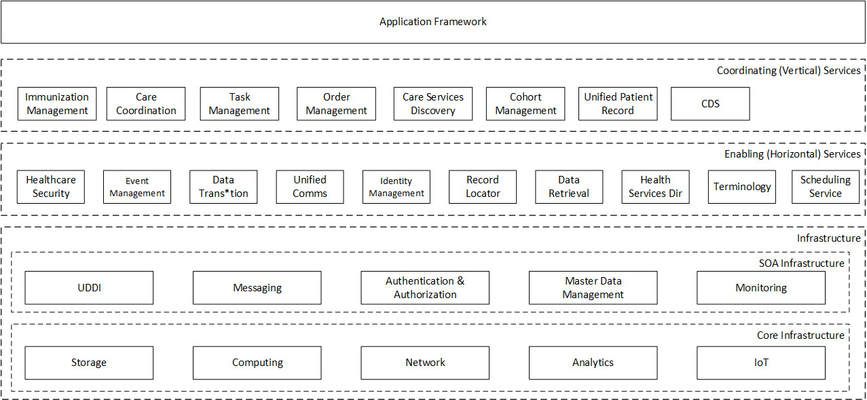This page contains the draft version of the HSPC functional architecture specification, and serves as a hub for the various task forces working on different aspects of the HSPC architecture.
HSPC Architecture Proposals
The HSPC functional specification is based on a layered, "pyramidal" architecture.
- The Infrastructure layer contains the foundation services. These are commodity capabilities available from most infrastructure providers. The Core Infrastructure are base services that all systems and architectures would use, and are not necessarily specific to the support of Service Oriented Architectures
- The SOA Infrastructure layer incorporates SOA-oriented services that...
- The Enabling, or Horizontal Services layer contains services that are business oriented, but not inherently domain specific. These are the base "building blocks" to be used by more complicated, higher level services.
- The Coordinating, or Vertical Services layer contains healthcare domain specific services. These services are business oriented services. and generally utilize, by composition or orchestration, the Enabling Services, leveraging domain-specific content as guidance.
Core Infrastructure
This is a general purpose cloud infrastructure, not specific to healthcare.
A few relevant requirements are listed here:
- Storage
Storage solutions should not be limited to relational DBs, but include a combination of graph, document, XML, object, key-value, column and other "NOSQL" databases, to afford for optimal solutions based on applications' needs. - Computing
- Network
- Analytics
Analytics - as in the materialization of the HSPC knowledge architecture within the HSPC service architecture is a broader notion that spans across the stack.
This is in contrast with a more focused notion of analytics as in the application of data mining and visualization techniques to large data sets (e.g. using SAS, R or Tableau) - Internet of Things (IoT)
Particular emphasis should be given to device and device data integration across the stack.
SOA Infrastructure
This is general purpose SOA Infrastructure, not specific to healthcare.
| Service | Description | Requirements | Standards | Implementations | Use Cases |
|---|---|---|---|---|---|
| UDDI | |||||
| Messaging | |||||
Authentication and Authorization | |||||
Master Data Management | |||||
| Monitoring |
- UDDI
- Messaging
- Authentication and Authorization
- Master Data Management
- Monitoring
Enabling (Horizontal) Services:
| Service | Description | Requirements | Standards | Implementations | |
|---|---|---|---|---|---|
| Healthcare Security Services | |||||
| Authentication and Authorization | |||||
| Access Control |
| ||||
| Audit | Provides a consolidated audit trail of all access and changes to PHI |
| |||
| Consent | A service to record and enforce a patient's consent directives. | ||||
| Event Management | Common mechanism for platforms to publish and consumers to subscribe to useful events occurring inside the platform/EHR. | (FHIR Messaging and Subscription model) | HSPC | ||
| Data Trans*tion | Converts data and information between representations:
| ||||
| Terminology | Expand coded concepts, valuesets and post-coordinated expressions. Resolve concept descriptions Manages versioning | ||||
| Unified Communications | Define a way for platform consumers to raise (write) alerts, reminders and/or notifications inside the platform/EHR. Should leverage roles, delivery channels, user preferences, etc.. | ||||
| Identity Management | Correlates records (entries), discovering identities | ||||
| Health Services Directory | Manage an organization's (non-technical) services and capabilities | ||||
| Scheduling | |||||
| Record Locator | |||||
| Data Retrieval | |||||
Coordinating (Vertical) Services :
| Service | Description | Requirements | Standards | Implementations | Use Cases |
|---|---|---|---|---|---|
| Immunization Management | Assist with immunization schedules | ||||
| Care Coordination | Support the coordination of care (delivery) across institutions | ||||
| Task Management | Traces and manages tasks | ||||
| Order Management | Handling the lifecycle of orders in a clinical workflow |
| |||
| Care Services Discovery | |||||
| Cohort Management | Manages adding patients to cohorts | ||||
| Unified Patient Record | Provides a comprehensive view of an enriched patient record | ||||
| Clinical Decision Support | Invoke CDS logic on a (fragment of the) patient record |
Others (not in diagram):
| Service | Description | Requirements | Standards | Implementations | Use Cases |
|---|---|---|---|---|---|
| Knowledge Repository | A store for common knowledge artifacts - rules, quality measures, terminologies, etc.. | ||||
| Knowledge Management | A layer, usually associated to a K repository, that manages the curation, lifecycle, provenance, pedigree and distribution of knowledge assets | ||||
| Knowledge and Analytics Runtime | An aggregate Knowledge Execution functionality that supports the delivery of various "inference" capabilities: | ||||
| |||||
|
| ||||
|
| ||||
| |||||
|
| ||||
|
|
